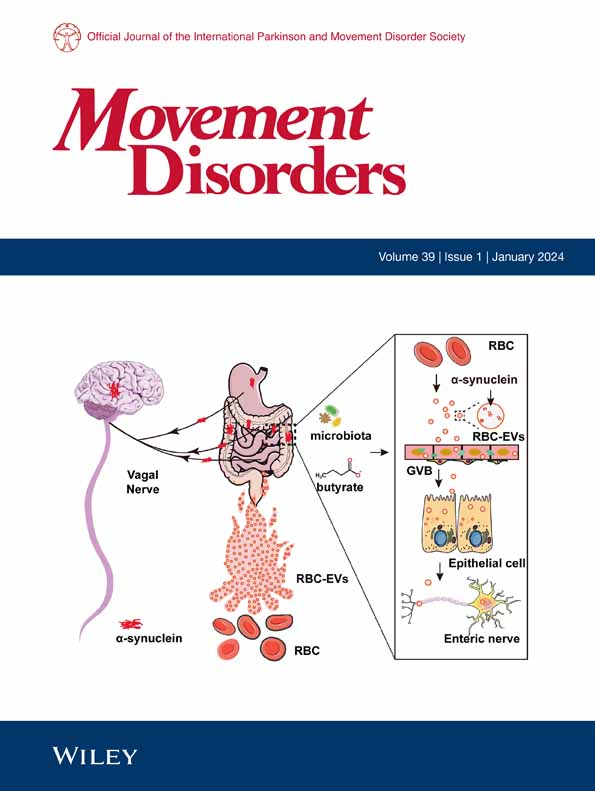Potential Disease‐Modifying Effects of Ganglioside GM1 Pulse Treatment on Spinocerebellar Ataxia Type 3, a Parallel‐Group, Double‐Blind, Randomized, Controlled Trial
Yong‐Kang Chen, Hai‐Yan Tian, Qing‐Yong Zhu, Rui Zhang, Dong‐Xiao Liang, Jiu‐Qi Wang, Ren‐Yi Feng, Chi Qin, Ming‐Ming Ma, Hong Jiang, Bei‐Sha Tang, Xue‐Bing Ding, Xue‐Jing Wang
求助PDF
{"title":"Potential Disease‐Modifying Effects of Ganglioside GM1 Pulse Treatment on Spinocerebellar Ataxia Type 3, a Parallel‐Group, Double‐Blind, Randomized, Controlled Trial","authors":"Yong‐Kang Chen, Hai‐Yan Tian, Qing‐Yong Zhu, Rui Zhang, Dong‐Xiao Liang, Jiu‐Qi Wang, Ren‐Yi Feng, Chi Qin, Ming‐Ming Ma, Hong Jiang, Bei‐Sha Tang, Xue‐Bing Ding, Xue‐Jing Wang","doi":"10.1002/mds.30050","DOIUrl":null,"url":null,"abstract":"BackgroundSpinocerebellar ataxia type 3 (SCA3) is an autosomal dominant inherited neurodegenerative disorder for which there is currently no cure, nor effective treatment strategy.ObjectiveOur aim was to investigate the safety and efficacy of high‐dose ganglioside GM1 (ganglioside‐monosialic acid) pulse treatment in patients with SCA3.MethodsPatients were randomly allocated to receive either high‐dose GM1 (400 mg on the first day followed by 200 mg/day), low‐dose GM1 (40 mg/day), or placebo (normal saline) for 4 weeks. The primary outcome, assessed by measuring the change in the Scale for the Assessment and Rating of Ataxia (SARA) scores from baseline to 12 weeks post‐treatment, is central to evaluating treatment efficacy. Secondary outcomes included changes in the International Cooperative Ataxia Rating Scale (ICARS) score, Barthel Index of Activities of Daily Living (ADL), and plasma and cerebrospinal fluid (CSF) GABA levels. Safety was assessed in all treated patients.ResultsA total of 48 patients with SCA3 were enrolled in this study. After 12 weeks, data from 43 patients were included in the efficacy analysis (intention‐to‐treat analysis). The least‐squares mean change in the SARA score from baseline to 12 weeks post‐treatment was −3.80 (standard error [SE], 0.39; 95% confidence interval [CI], −4.58 to −3.02) in the high‐dose GM1 group, 0.34 (SE, 0.40; 95% CI, −0.46 to 1.13) in the low‐dose GM1 group, and 0.73 (SE, 0.40; 95% CI, −0.07 to 1.52) in the placebo group, respectively. Secondary outcomes showed improvements in the ICARS score, Barthel Index of ADL, and plasma and CSF GABA levels in the high‐dose GM1 group compared to the low‐dose GM1 and placebo groups. All treatments were well‐tolerated and safe.ConclusionsHigh‐dose GM1 treatment significantly ameliorated ataxic symptoms in patients with SCA3. © 2024 International Parkinson and Movement Disorder Society.","PeriodicalId":213,"journal":{"name":"Movement Disorders","volume":null,"pages":null},"PeriodicalIF":7.4000,"publicationDate":"2024-11-07","publicationTypes":"Journal Article","fieldsOfStudy":null,"isOpenAccess":false,"openAccessPdf":"","citationCount":"0","resultStr":null,"platform":"Semanticscholar","paperid":null,"PeriodicalName":"Movement Disorders","FirstCategoryId":"3","ListUrlMain":"https://doi.org/10.1002/mds.30050","RegionNum":1,"RegionCategory":"医学","ArticlePicture":[],"TitleCN":null,"AbstractTextCN":null,"PMCID":null,"EPubDate":"","PubModel":"","JCR":"Q1","JCRName":"CLINICAL NEUROLOGY","Score":null,"Total":0}
引用次数: 0
引用
批量引用


